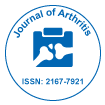CommentaryOpen Access
Pentosan Polysulfate as a Disease Modifier of Cartilage Degeneration in Experimental Osteoarthritis
Ahmed M Elmesiry1*, Magdi A Seleim2, Ali A Mansour3 and David Cullis-Hill4
1Diagnostic Imaging and Endoscopy, Animal Reproduction Research Institute, Agriculture Research Center, 12556 Haram, Giza, Egypt
2Department of Surgery, Kafrelsheikh University, 33156 Kafrelsheikh, Egypt
3Department of Anatomy, Kafrelsheikh University, 33156 Kafrelsheikh, Egypt
4Sylvan Scientific Pty Ltd, 111 Bronte Rd, Bondi Junction, Sydney, NSW 2022, Australia
- Ahmed M Elmesiry
Researcher, Animal Reproduction Research Institute Diagnostic Imaging and Endoscopy
5 El-Aharam Garden st, Al- Haram, Giza 12556, Egypt
Tel: +201062099431
E-mail: elmesiry@outlook.com
Received date: May 03, 2016; Accepted date: May 20, 2016; Published date: May 31, 2016
Citation: Elmesiry AM, Seleim MA, Mansour AA, Hill DC (2016) Pentosan Polysulfate as a Disease Modifier of Cartilage Degeneration in Experimental Osteoarthritis. J Arthritis 5:199. doi:10.4172/2167-7921.1000199
Copyright: © 2016 Elmesiry AM, et al. This is an open-access article distributed under the terms of the Creative Commons Attribution License, which permits unrestricted use, distribution, and reproduction in any medium, provided the original author and source are credited.
Visit for more related articles at Journal of Arthritis
Abstract
Reasons for performing study: Disease modifying drugs for Osteoarthritis (OA) is an important trend of development of an appropriate therapeutic protocol for both human and animal. To date no ideal OA treatment protocol has been described. Objectives: To assess clinical, histologic, and biochemical effects of sodium pentosan polysulfate (NaPPS) administered intramuscullary (IM) for treatment of experimentally induced osteoarthritis in donkeys. Study design: OA was induced using repeated injection of allogenous donkey cartilage. Six donkeys received NaPPS (3 mg/kg, IM) on study days 70, 77, 84, and 91. Six control donkeys received the same volume of saline (0.9% w/v NaCl) IM on study days 70, 77, 84, and 91. Clinical, gross, histologic, histochemical, and biochemical findings as well as synovial fluid analysis were evaluated. Methods of testing hypotheses: Lameness score, carpal circumference, joint flexion angle, Synovial fluid analysis, light and scanning electron microscopy were evaluated. Results: Induction of osteoarthritis caused increase in the lameness score, joint circumference,synovial fluid calcium, phosphorus, magnesium, total protein and leukocyte count and cartilage damage. NaPPS treatment significantly reduced synovial fluid Ca, Mg, P and cartilage damage. Conclusions: NaPPS resulted in significant improvement in clinical signs and articular cartilage healing, and no adverse effects were detected confirming that NaPPS has disease-modifying properties. Potential relevance: NaPPS is a suitable therapeutic option for osteoarthritis in equines.
